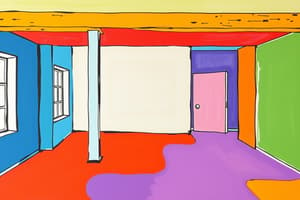Podcast
Questions and Answers
What is the primary function of air intakes and outlets in a ventilation system?
What is the primary function of air intakes and outlets in a ventilation system?
- To regulate air pressure
- To provide shading devices
- To filter the air
- To circulate air throughout the building (correct)
Which of the following heat transfer modes involves direct heat transfer between objects in physical contact?
Which of the following heat transfer modes involves direct heat transfer between objects in physical contact?
- Insulation
- Radiation
- Convection
- Conduction (correct)
What is the unit of power used to measure heat transfer?
What is the unit of power used to measure heat transfer?
- Watt (W) (correct)
- Kelvin (K)
- Joule (J)
- Calorie (cal)
Which thermal comfort index predicts the percentage of occupants dissatisfied with thermal comfort?
Which thermal comfort index predicts the percentage of occupants dissatisfied with thermal comfort?
What is the purpose of shading devices in heat transfer mechanisms?
What is the purpose of shading devices in heat transfer mechanisms?
What is the primary standard for thermal comfort in commercial buildings in the United States?
What is the primary standard for thermal comfort in commercial buildings in the United States?
Flashcards are hidden until you start studying
Study Notes
Ventilation Systems
- Types of Ventilation Systems:
- Natural Ventilation: uses natural forces (wind, temperature differences) to circulate air
- Mechanical Ventilation: uses fans and ducts to circulate air
- Hybrid Ventilation: combines natural and mechanical ventilation
- Ventilation System Components:
- Air intakes and outlets
- Ducts and fans
- Filters and humidifiers (optional)
- Ventilation System Design Considerations:
- Building orientation and layout
- Climate and weather patterns
- Occupant density and activity levels
- Indoor air quality (IAQ) and pollution control
Heat Transfer
- Heat Transfer Modes:
- Conduction: direct heat transfer between objects in physical contact
- Convection: heat transfer through fluid motion (air or water)
- Radiation: heat transfer through electromagnetic waves
- Heat Transfer Mechanisms:
- Insulation: reduces heat transfer through materials
- Ventilation: removes heat through air circulation
- Shading: reduces heat gain through shading devices
- Heat Transfer Units:
- Watt (W): unit of power
- Joule (J): unit of energy
- Kelvin (K): unit of temperature
Thermal Comfort Indices
- Thermal Comfort Indices:
- Predicted Mean Vote (PMV): predicts occupant thermal comfort based on air temperature, humidity, and air movement
- Predicted Percentage of Dissatisfied (PPD): predicts percentage of occupants dissatisfied with thermal comfort
- Thermal Sensation Vote (TSV): measures occupant thermal comfort on a scale from -3 to +3
- Thermal Comfort Factors:
- Air temperature
- Humidity
- Air movement
- Radiant temperature
- Clothing and activity levels
- Thermal Comfort Standards:
- ASHRAE Standard 55: thermal comfort standard for commercial buildings
- ISO 7730: thermal comfort standard for indoor environments
Ventilation Systems
- Natural Ventilation uses natural forces such as wind and temperature differences to circulate air.
- Mechanical Ventilation uses fans and ducts to circulate air.
- Hybrid Ventilation combines natural and mechanical ventilation.
Ventilation System Components
- Air intakes and outlets are components of ventilation systems.
- Ducts and fans are used to circulate air in ventilation systems.
- Filters and humidifiers are optional components in ventilation systems.
Ventilation System Design Considerations
- Building orientation and layout are considered in ventilation system design.
- Climate and weather patterns are considered in ventilation system design.
- Occupant density and activity levels are considered in ventilation system design.
- Indoor air quality (IAQ) and pollution control are considered in ventilation system design.
Heat Transfer
- Conduction is a mode of heat transfer that occurs through direct contact between objects.
- Convection is a mode of heat transfer that occurs through fluid motion (air or water).
- Radiation is a mode of heat transfer that occurs through electromagnetic waves.
Heat Transfer Mechanisms
- Insulation reduces heat transfer through materials.
- Ventilation removes heat through air circulation.
- Shading reduces heat gain through shading devices.
Heat Transfer Units
- Watt (W) is the unit of power.
- Joule (J) is the unit of energy.
- Kelvin (K) is the unit of temperature.
Thermal Comfort Indices
- Predicted Mean Vote (PMV) predicts occupant thermal comfort based on air temperature, humidity, and air movement.
- Predicted Percentage of Dissatisfied (PPD) predicts the percentage of occupants dissatisfied with thermal comfort.
- Thermal Sensation Vote (TSV) measures occupant thermal comfort on a scale from -3 to +3.
Thermal Comfort Factors
- Air temperature is a factor in thermal comfort.
- Humidity is a factor in thermal comfort.
- Air movement is a factor in thermal comfort.
- Radiant temperature is a factor in thermal comfort.
- Clothing and activity levels are factors in thermal comfort.
Thermal Comfort Standards
- ASHRAE Standard 55 is the thermal comfort standard for commercial buildings.
- ISO 7730 is the thermal comfort standard for indoor environments.
Studying That Suits You
Use AI to generate personalized quizzes and flashcards to suit your learning preferences.




